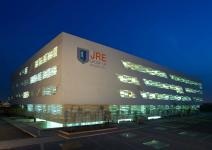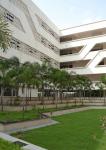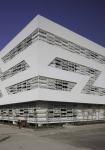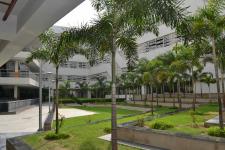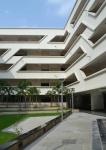The design brief was to create a new Urban Development on the Outskirts of the City-An Urban spread that allows for Infinite Possibility and flexibility, yet defines the Academic Settlement. The Development is envisaged as a dense urban collage derived from its local climatic conditions. The planning process is a derivative of the definition of three main zones- Public Zone (Academic), Semi Public and Private Zone (Residential) and an overlay of these is a key Design determinant. The master plan aims to create a mini urban settlement which generates a Socio-Cultural Built environment similar to that of a City and is suited to the function of a University Campus while shaping an educational institution. Various morphologies were tested to achieve an optimum sense of balance of built and open space, suited to the space requirements. With the identified planning goals in mind, the morphology has, to a significant degree, established the overall patterns defined within the Master Plan.
It is proposed to create a Sustainable Eco-Friendly campus, with spaces that respond to local Climatic conditions. This would also facilitate interaction and the creation of a Synergy between disciplines and departments. Vehicular movement is restricted along the peripheral network, while the internal primary, secondary, and tertiary streets are for pedestrian movement. This network of streets would encourage walking and cycling within the campus. The shaded walkways and narrow streets are articulated by exploring the nature of traditional streets to create a pedestrian-friendly environment.
The Academic Block is a part of the first phase of the master plan. The building is an elevated structure with a scooped out underbelly that is thermally banked to create a recreational space which remains cool throughout the summer. The underbelly is an enclosed space, cooled by water bodies, and is approached through step-wells leading down from the corners of the building that are open for entry and exit, finished with landscape greens. The intent was to define each corner of the building as a different design element so that no two corners look the same. One of the unique features of the building is a centerpiece staircase on the Southeast inner courtyard of the building with interweaving stairs spilling out into small break out spaces at the edges. The ground floor area includes the receptions, offices and other administrative rooms, the first, and the second floors are equipped with the library next to the staircase for easy access, while the third floor is dedicated to classrooms and seminar rooms. The façade was carefully designed with Jaali screens that help protect sun exposed areas in the summer months. The Jaali pattern is in the shape of louvers that closely follow the summer path of the sun across the façade provide the most shade during the summer while allowing in the most light during the winter. It allows natural ventilation while minimizing dust and regulates the temperatures within a 5-degree comfort range.
Passive environmental techniques aid in achieving lower temperatures in the extreme summers. The courtyards and corridors are cooled through evaporative cooling and allow natural cross ventilation of the buildings. Vegetation further enhances evaporative cooling in the courtyard and helps insulate the roof from the direct rays of the sun. The campus is being built in three phases with the first phase, being the construction of the Academic Block. The remaining phases would bring along the development of the Sports Centre, Student Centre, and Public Facilities such as the Convention centre, auditorium and the remainder of the Residential Block.
2009
2013

